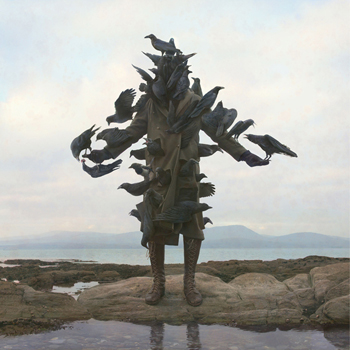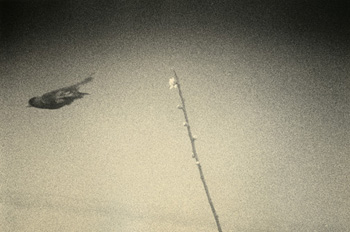
Yancey Richardson Gallery signaled appreciation for the naturalist John Burroughs by naming the summer group show Beautiful Vagabonds, the writer’s poetic keywords for birds. Few works exemplified a naturalist’s approach to photography, however, demonstrating fitting curatorial restraint for a subject-based show intent on catholicity. Among them Sustenance #114 by Neeta Madahar, Policeman by Jitka Hanzlová, American Goldfinches by Paula McCartney, and Terry Evans’ Field Museum, Drawer of Eastern Meadowlarks, works corresponding to what one would see in a natural history museum.
These are not the birds of our youth mentioned in Burroughs’ Birds and Poets either, the ones that “remain forever the same”. Some are disturbing birds. Richard Barnes, Murmur #1, an ominously tornado-like swarm of birds, Alex Prager’s video still Eve, capturing the socialite character in Hitchcock’s “The Birds” fending off pigeons in this case, not seagulls; or Bertien van Manen’s St. Petersberg (Birds in Room), in which dilapidated state housing meets Columbidae, and Kahn & Selesnick’s King of the Bird, a Magritte’s Man in the Bowler Hat scare-crow with two dozen very large birds.

Masao Yamamoto, Untitled # 1601 from the series Kawa=Flow
Others have messages. Birdcalls, on loan from the Sol LeWitt Foundation, signaled an appreciation of the mischievous bird. Birdcalls is an audio work of Louise Lawler’s catcalls of 28 male artist names as irreverent and shrill as it is hilarious. Also, Barbara Bosworth’s portrait Indigo Bunting which updates medieval depictions of birds as messengers—the woman’s manicured nails notwithstanding humanizing the interaction.
Many were birds with less to say. Esko Männikkö’s images, reminiscence of Roni Horn’s taxidermic Bird series, are the heads of birds shot from behind, as mute as pink flamingo lawn ornaments. Sanna Kannisto’s birds were contextually mute, and far more interesting in her book Fieldwork which documents her photographic experiences in the rainforest.
But it was Masao Yamamoto’s bird, silent but spirited, in a pair of gelatin prints that were the most successful pieces in the show. By engaging the viewer in the anticipation of flight, our strongest association by far with our avian friends, it helped Beautiful Vagabonds achieve an objective of sorts. Burroughs said it best: “The true poet knows more about Nature than the naturalist because he carries her open secrets in his heart”.

 RSS
RSS
